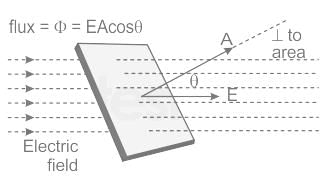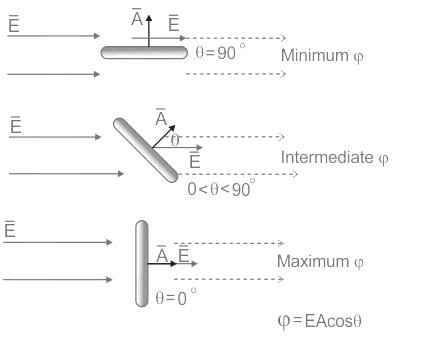Electrical Engineering (EE) Exam > Electrical Engineering (EE) Questions > According to gauss theorem, the electric flux...
Start Learning for Free
According to gauss theorem, the electric flux on a closed surface depends on?
- a)The area of open surface
- b)Charge enclosed
- c)Magnetic field of charge
- d)Charge outside the sphere
Correct answer is option 'B'. Can you explain this answer?
Verified Answer
According to gauss theorem, the electric flux on a closed surface depe...
CONCEPT
- Electric Flux: It is defined as the number of electric field lines passing through the perpendicular unit area.

- Electric Flux = (Φ) = EA⊥ [E = electric field, A = perpendicular area]
- Electric flux (Φ) = EA cos θ [where θ is the angle between area plane and electric field]

- The flux is maximum when the angle is 0°
- Gauss Law: According to gauss’s law, total electric flux through a closed surface enclosing a charge is 1/ϵ0 times the magnitude of charge enclosed.

Where, Φ = electric flux, Qin = charge enclosed the sphere, ϵ0 = permittivity of space (8.85 × 10-12 C2/Nm2), dS = surface area
According to gauss’s law,
The flux of the net electric field through a closed surface equals the net charge enclosed by the surface divided by ϵ0.

Electric flux on a closed surface only depends on the enclosed charge.
∴ Option 2 is correct
Most Upvoted Answer
According to gauss theorem, the electric flux on a closed surface depe...
CONCEPT
- Electric Flux: It is defined as the number of electric field lines passing through the perpendicular unit area.

- Electric Flux = (Φ) = EA⊥ [E = electric field, A = perpendicular area]
- Electric flux (Φ) = EA cos θ [where θ is the angle between area plane and electric field]

- The flux is maximum when the angle is 0°
- Gauss Law: According to gauss’s law, total electric flux through a closed surface enclosing a charge is 1/ϵ0 times the magnitude of charge enclosed.

Where, Φ = electric flux, Qin = charge enclosed the sphere, ϵ0 = permittivity of space (8.85 × 10-12 C2/Nm2), dS = surface area
According to gauss’s law,
The flux of the net electric field through a closed surface equals the net charge enclosed by the surface divided by ϵ0.

Electric flux on a closed surface only depends on the enclosed charge.
∴ Option 2 is correct
Free Test
FREE
| Start Free Test |
Community Answer
According to gauss theorem, the electric flux on a closed surface depe...
Explanation:
Electric flux on a closed surface is defined by Gauss's Law, which relates the electric flux passing through a closed surface to the charge enclosed by that surface.
Charge enclosed:
- The electric flux on a closed surface depends on the amount of charge enclosed by that surface.
- The more charge enclosed, the greater the electric flux passing through the surface.
Effect of other factors:
- The area of the open surface does not directly affect the electric flux on a closed surface. The flux depends on the charge distribution, not the size of the surface.
- The magnetic field of the charge also does not affect the electric flux. The electric flux is solely determined by the electric field produced by the charge.
Mathematical representation:
- Mathematically, Gauss's Law can be expressed as Φ = Q/ε₀, where Φ is the electric flux, Q is the charge enclosed by the surface, and ε₀ is the permittivity of free space.
Therefore, the electric flux on a closed surface depends on the charge enclosed by that surface according to Gauss's Law.
Electric flux on a closed surface is defined by Gauss's Law, which relates the electric flux passing through a closed surface to the charge enclosed by that surface.
Charge enclosed:
- The electric flux on a closed surface depends on the amount of charge enclosed by that surface.
- The more charge enclosed, the greater the electric flux passing through the surface.
Effect of other factors:
- The area of the open surface does not directly affect the electric flux on a closed surface. The flux depends on the charge distribution, not the size of the surface.
- The magnetic field of the charge also does not affect the electric flux. The electric flux is solely determined by the electric field produced by the charge.
Mathematical representation:
- Mathematically, Gauss's Law can be expressed as Φ = Q/ε₀, where Φ is the electric flux, Q is the charge enclosed by the surface, and ε₀ is the permittivity of free space.
Therefore, the electric flux on a closed surface depends on the charge enclosed by that surface according to Gauss's Law.

|
Explore Courses for Electrical Engineering (EE) exam
|

|
Question Description
According to gauss theorem, the electric flux on a closed surface depends on?a)The area of open surfaceb)Charge enclosedc)Magnetic field of charged)Charge outside the sphereCorrect answer is option 'B'. Can you explain this answer? for Electrical Engineering (EE) 2025 is part of Electrical Engineering (EE) preparation. The Question and answers have been prepared according to the Electrical Engineering (EE) exam syllabus. Information about According to gauss theorem, the electric flux on a closed surface depends on?a)The area of open surfaceb)Charge enclosedc)Magnetic field of charged)Charge outside the sphereCorrect answer is option 'B'. Can you explain this answer? covers all topics & solutions for Electrical Engineering (EE) 2025 Exam. Find important definitions, questions, meanings, examples, exercises and tests below for According to gauss theorem, the electric flux on a closed surface depends on?a)The area of open surfaceb)Charge enclosedc)Magnetic field of charged)Charge outside the sphereCorrect answer is option 'B'. Can you explain this answer?.
According to gauss theorem, the electric flux on a closed surface depends on?a)The area of open surfaceb)Charge enclosedc)Magnetic field of charged)Charge outside the sphereCorrect answer is option 'B'. Can you explain this answer? for Electrical Engineering (EE) 2025 is part of Electrical Engineering (EE) preparation. The Question and answers have been prepared according to the Electrical Engineering (EE) exam syllabus. Information about According to gauss theorem, the electric flux on a closed surface depends on?a)The area of open surfaceb)Charge enclosedc)Magnetic field of charged)Charge outside the sphereCorrect answer is option 'B'. Can you explain this answer? covers all topics & solutions for Electrical Engineering (EE) 2025 Exam. Find important definitions, questions, meanings, examples, exercises and tests below for According to gauss theorem, the electric flux on a closed surface depends on?a)The area of open surfaceb)Charge enclosedc)Magnetic field of charged)Charge outside the sphereCorrect answer is option 'B'. Can you explain this answer?.
Solutions for According to gauss theorem, the electric flux on a closed surface depends on?a)The area of open surfaceb)Charge enclosedc)Magnetic field of charged)Charge outside the sphereCorrect answer is option 'B'. Can you explain this answer? in English & in Hindi are available as part of our courses for Electrical Engineering (EE).
Download more important topics, notes, lectures and mock test series for Electrical Engineering (EE) Exam by signing up for free.
Here you can find the meaning of According to gauss theorem, the electric flux on a closed surface depends on?a)The area of open surfaceb)Charge enclosedc)Magnetic field of charged)Charge outside the sphereCorrect answer is option 'B'. Can you explain this answer? defined & explained in the simplest way possible. Besides giving the explanation of
According to gauss theorem, the electric flux on a closed surface depends on?a)The area of open surfaceb)Charge enclosedc)Magnetic field of charged)Charge outside the sphereCorrect answer is option 'B'. Can you explain this answer?, a detailed solution for According to gauss theorem, the electric flux on a closed surface depends on?a)The area of open surfaceb)Charge enclosedc)Magnetic field of charged)Charge outside the sphereCorrect answer is option 'B'. Can you explain this answer? has been provided alongside types of According to gauss theorem, the electric flux on a closed surface depends on?a)The area of open surfaceb)Charge enclosedc)Magnetic field of charged)Charge outside the sphereCorrect answer is option 'B'. Can you explain this answer? theory, EduRev gives you an
ample number of questions to practice According to gauss theorem, the electric flux on a closed surface depends on?a)The area of open surfaceb)Charge enclosedc)Magnetic field of charged)Charge outside the sphereCorrect answer is option 'B'. Can you explain this answer? tests, examples and also practice Electrical Engineering (EE) tests.

|
Explore Courses for Electrical Engineering (EE) exam
|

|
Signup for Free!
Signup to see your scores go up within 7 days! Learn & Practice with 1000+ FREE Notes, Videos & Tests.


















